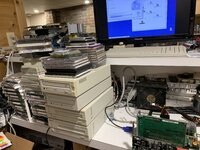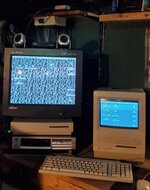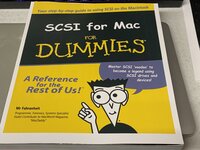ToneMalone
Active member
Hey all! Just got my External DB25 BlueSCSI V2 in the mail today. Super excited to get wifi working on my LCIII+ and wanted a simple way to copy files from Basilisk II emulator.
I have internal SCSI2SD v5.1 setup as follows
SCSI[0] 2GB boot HFS (MacOS 8.1/ MacOS 7.5.5)
SCSI[1] 10GB HFS+ (stuff1)
SCSI[2] 10GB HFS+ (stuff2)
Termination ON (will not boot with it disabled; does not see drive ( ? floppy on boot))
this works great.
when I insert the BlueSCSI and boot, the mouse freezes almost immediately, nothing else happens.
I've also tried using my ZIP drive set to SCSI ID 5/6 and termination on/off. This will change the chime depending on termination (error chime?), but freezes either way.
I've configured my bluescsi.ini as follows
in root folder of SD card I have
HD30_512 2048 MB.hda
NE4.hda
bluescsi.ini
Here is my log.txt after attempted boot
What am I missing here? a conflict on - SELECTION: 3 ?
Is this SCSI id3?
I've also tried renaming image such as
HD50_512 2048 MB.hda
HD60_512 2048 MB.hda
(I also have an SE/30 with internal ZuluSCSI, i have not tried it with the BlueSCSI yet)
Any help is much appreaciated!!!
Cheers - Tom
I have internal SCSI2SD v5.1 setup as follows
SCSI[0] 2GB boot HFS (MacOS 8.1/ MacOS 7.5.5)
SCSI[1] 10GB HFS+ (stuff1)
SCSI[2] 10GB HFS+ (stuff2)
Termination ON (will not boot with it disabled; does not see drive ( ? floppy on boot))
this works great.
when I insert the BlueSCSI and boot, the mouse freezes almost immediately, nothing else happens.
I've also tried using my ZIP drive set to SCSI ID 5/6 and termination on/off. This will change the chime depending on termination (error chime?), but freezes either way.
I've configured my bluescsi.ini as follows
[SCSI]
WiFiSSID=TELUS3206-2.4G
WiFiPassword=**************
Debug=1
in root folder of SD card I have
HD30_512 2048 MB.hda
NE4.hda
bluescsi.ini
Here is my log.txt after attempted boot
Platform: BlueSCSI Pico
FW Version: 2023.10.12-release Oct 13 2023 02:55:19
Flash chip size: 2048 kB
=== SD Card Info ===
SD card detected, exFAT volume size: 61053 MB
SD Name: 00000, MID: 0x1B, OID: 0x53 0x4D
[144ms]
[144ms] === Global Config ===
[146ms] Reading configuration from bluescsi.ini
[146ms] Active configuration:
[146ms] DBG -- SelectionDelay: 255
[147ms] DBG -- EnableUnitAttention is off
[147ms] DBG -- EnableSCSI2 is on
[148ms] DBG -- EnableSelLatch is off
[148ms] DBG -- MapLunsToIDs is off
[148ms] -- Debug is enabled
[149ms] DBG -- Parity is enabled
[149ms] DBG -- ReinsertCDOnInquiry is disabled
[183ms]
[183ms] === Finding images in / ===
[185ms] == Opening /HD30_512 2048 MB.hda for ID: 3 LUN: 0
[188ms] DBG ---- Read prefetch enabled: 8192 bytes
[189ms] DBG ---- Valid Macintosh Device Image detected.
[190ms] ---- Image ready
[190ms] == Opening /NE4.hda for ID: 4 LUN: 0
[194ms] ---- Configuring as network based on image name
[194ms] DBG ---- Read prefetch enabled: 8192 bytes
[195ms] ---- Image ready
[195ms]
[195ms] === ROM Drive ===
[195ms] Platform supports ROM drive up to 1692 kB
[196ms] ---- ROM drive image not detected
[196ms]
[196ms] === Configured SCSI Devices ===
[196ms] * ID: 3, BlockSize: 512, Type: Fixed, Quirks: Apple, Size: 2097216kB
[197ms] * ID: 4, Type: Network, Quirks: Apple
[956ms]
[956ms] === Network Initialization ===
[957ms] Unique board id: e6 61 41 04 03 5f ba 2e
[1820ms] Wi-Fi MAC: 00:80:19:04:03:5F
[1820ms] Connecting to Wi-Fi SSID "TELUS3206-2.4G" with WPA/WPA2 PSK
[1837ms]
[1837ms] Initialization complete!
[1903ms] INFO: Pico Voltage: 3.232V.
[3335ms] DBG BUS RESET
[7409ms] DBG -- BUS_BUSY
[7410ms] DBG -- BUS_FREE
[7702ms] DBG -- BUS_BUSY
[7702ms] DBG -- BUS_FREE
[7992ms] DBG -- BUS_BUSY
[7993ms] DBG ---- SELECTION: 4
[7994ms] DBG ---- COMMAND: Read6
[7994ms] DBG ------ OUT: 0x08 0x00 0x00 0x00 0x01 0x00
[7995ms] in scsiNetworkCommand with command 0x08 (size 1)
[7995ms] DBG ---- STATUS: 2 CHECK_CONDITION, sense 0x00000000
[8001ms] DBG ---- MESSAGE_IN
[8002ms] DBG ------ IN: 0x00
[8003ms] DBG -- BUS_FREE
[8003ms] DBG ---- SELECTION: 4
[8004ms] DBG ---- COMMAND: Read6
[8004ms] DBG ------ OUT: 0x08 0x00 0x00 0x00 0x01 0x00
[8005ms] in scsiNetworkCommand with command 0x08 (size 1)
[8005ms] DBG ---- STATUS: 2 CHECK_CONDITION, sense 0x00000000
[8013ms] DBG ---- MESSAGE_IN
[8014ms] DBG ------ IN: 0x00
[8015ms] DBG -- BUS_FREE
[8015ms] DBG ---- SELECTION: 3
[8016ms] DBG ---- COMMAND: Read6
[8016ms] DBG ------ OUT: 0x08 0x00 0x00 0x00 0x01 0x00
[8017ms] DBG ------ Read 1x512 starting at 0
[8018ms] DBG ---- DATA_IN
[8019ms] DBG ---- Total IN: 512 OUT: 0 CHECKSUM: 44262
[8019ms] DBG ---- STATUS: 0 GOOD
[8027ms] DBG ---- MESSAGE_IN
[8027ms] DBG ------ IN: 0x00
[8028ms] DBG -- BUS_FREE
[8053ms] DBG -- BUS_BUSY
[8053ms] DBG ---- SELECTION: 3
[8055ms] DBG ---- COMMAND: Read6
[8055ms] DBG ------ OUT: 0x08 0x00 0x00 0x40 0x13 0x00
[8055ms] DBG ------ Read 19x512 starting at 64
[8056ms] DBG ---- DATA_IN
[8069ms] DBG ---- Total IN: 9728 OUT: 0 CHECKSUM: 39133
[8069ms] DBG ---- STATUS: 0 GOOD
[8077ms] DBG ---- MESSAGE_IN
[8077ms] DBG ------ IN: 0x00
[8078ms] DBG -- BUS_FREE
[8078ms] DBG ---- SELECTION: 3
[8080ms] DBG ---- COMMAND: Read6
[8080ms] DBG ------ OUT: 0x08 0x00 0x00 0x01 0x01 0x00
[8080ms] DBG ------ Read 1x512 starting at 1
[8081ms] DBG ---- DATA_IN
[8083ms] DBG ---- Total IN: 512 OUT: 0 CHECKSUM: 51653
[8083ms] DBG ---- STATUS: 0 GOOD
[8088ms] DBG ---- MESSAGE_IN
[8088ms] DBG ------ IN: 0x00
[8090ms] DBG -- BUS_FREE
[8090ms] DBG ---- SELECTION: 3
[8091ms] DBG ---- COMMAND: Read6
[8091ms] DBG ------ OUT: 0x08 0x00 0x00 0x02 0x01 0x00
[8092ms] DBG ------ Read 1x512 starting at 2
[8093ms] DBG ---- DATA_IN
[8093ms] DBG ------ Found 1 sectors in prefetch cache
[8094ms] DBG ---- Total IN: 512 OUT: 0 CHECKSUM: 27143
[8094ms] DBG ---- STATUS: 0 GOOD
[8100ms] DBG ---- MESSAGE_IN
[8100ms] DBG ------ IN: 0x00
[8101ms] DBG -- BUS_FREE
[8105ms] DBG -- BUS_BUSY
[8105ms] DBG ---- SELECTION: 3
[8107ms] DBG ---- COMMAND: Read6
[8107ms] DBG ------ OUT: 0x08 0x00 0x00 0x01 0x01 0x00
[8107ms] DBG ------ Read 1x512 starting at 1
[8108ms] DBG ---- DATA_IN
[8109ms] DBG ---- Total IN: 512 OUT: 0 CHECKSUM: 51653
[8110ms] DBG ---- STATUS: 0 GOOD
[8114ms] DBG ---- MESSAGE_IN
[8114ms] DBG ------ IN: 0x00
[8115ms] DBG -- BUS_FREE
[8115ms] DBG ---- SELECTION: 3
[8117ms] DBG ---- COMMAND: Read6
[8117ms] DBG ------ OUT: 0x08 0x00 0x00 0x02 0x01 0x00
[8117ms] DBG ------ Read 1x512 starting at 2
[8118ms] DBG ---- DATA_IN
[8118ms] DBG ------ Found 1 sectors in prefetch cache
[8119ms] DBG ---- Total IN: 512 OUT: 0 CHECKSUM: 27143
[8119ms] DBG ---- STATUS: 0 GOOD
[8124ms] DBG ---- MESSAGE_IN
[8124ms] DBG ------ IN: 0x00
[8125ms] DBG -- BUS_FREE
[8125ms] DBG -- BUS_BUSY
[8125ms] DBG ---- SELECTION: 3
[8127ms] DBG ---- COMMAND: Read6
[8127ms] DBG ------ OUT: 0x08 0x00 0x00 0x03 0x01 0x00
[8127ms] DBG ------ Read 1x512 starting at 3
[8128ms] DBG ---- DATA_IN
[8128ms] DBG ------ Found 1 sectors in prefetch cache
[8129ms] DBG ---- Total IN: 512 OUT: 0 CHECKSUM: 55902
[8129ms] DBG ---- STATUS: 0 GOOD
[8132ms] DBG ---- MESSAGE_IN
[8133ms] DBG ------ IN: 0x00
[8134ms] DBG -- BUS_FREE
[8137ms] DBG -- BUS_BUSY
[8137ms] DBG ---- SELECTION: 3
[8138ms] DBG ---- COMMAND: Read10
[8138ms] DBG ------ OUT: 0x28 0x00 0x00 0x00 0x00 0x01
[8139ms] DBG ------ OUT: 0x00 0x00 0x01 0x00
[8139ms] DBG ------ Read 1x512 starting at 1
[8140ms] DBG ---- DATA_IN
[8142ms] DBG ---- Total IN: 512 OUT: 0 CHECKSUM: 51653
[8142ms] DBG ---- STATUS: 0 GOOD
[8147ms] DBG ---- MESSAGE_IN
[8147ms] DBG ------ IN: 0x00
[8148ms] DBG -- BUS_FREE
[8148ms] DBG ---- SELECTION: 3
[8150ms] DBG ---- COMMAND: Read10
[8150ms] DBG ------ OUT: 0x28 0x00 0x00 0x00 0x00 0x02
[8150ms] DBG ------ OUT: 0x00 0x00 0x01 0x00
[8151ms] DBG ------ Read 1x512 starting at 2
[8151ms] DBG ---- DATA_IN
[8152ms] DBG ------ Found 1 sectors in prefetch cache
[8152ms] DBG ---- Total IN: 512 OUT: 0 CHECKSUM: 27143
[8152ms] DBG ---- STATUS: 0 GOOD
[8157ms] DBG ---- MESSAGE_IN
[8157ms] DBG ------ IN: 0x00
[8158ms] DBG -- BUS_FREE
[8158ms] DBG -- BUS_BUSY
[8158ms] DBG ---- SELECTION: 3
[8160ms] DBG ---- COMMAND: Read10
[8160ms] DBG ------ OUT: 0x28 0x00 0x00 0x00 0x00 0x03
[8160ms] DBG ------ OUT: 0x00 0x00 0x01 0x00
[8161ms] DBG ------ Read 1x512 starting at 3
[8162ms] DBG ---- DATA_IN
[8162ms] DBG ------ Found 1 sectors in prefetch cache
[8162ms] DBG ---- Total IN: 512 OUT: 0 CHECKSUM: 55902
[8163ms] DBG ---- STATUS: 0 GOOD
[8167ms] DBG ---- MESSAGE_IN
[8167ms] DBG ------ IN: 0x00
[8168ms] DBG -- BUS_FREE
[8170ms] DBG -- BUS_BUSY
[8173ms] DBG -- BUS_FREE
[8177ms] DBG -- BUS_BUSY
[8177ms] DBG -- BUS_FREE
[8179ms] DBG -- BUS_BUSY
[8216ms] DBG -- BUS_FREE
[8216ms] DBG -- BUS_BUSY
[8216ms] DBG -- BUS_FREE
[8218ms] DBG -- BUS_BUSY
[8221ms] DBG -- BUS_FREE
[8221ms] DBG -- BUS_BUSY
[8221ms] DBG -- BUS_FREE
[8223ms] DBG -- BUS_BUSY
[8227ms] DBG -- BUS_FREE
[8227ms] DBG -- BUS_BUSY
[8227ms] DBG -- BUS_FREE
[8229ms] DBG -- BUS_BUSY
[8232ms] DBG -- BUS_FREE
[8233ms] DBG -- BUS_BUSY
[8233ms] DBG -- BUS_FREE
[8235ms] DBG -- BUS_BUSY
[8237ms] DBG -- BUS_FREE
[8237ms] DBG -- BUS_BUSY
[8237ms] DBG -- BUS_FREE
[8239ms] DBG -- BUS_BUSY
[8244ms] DBG -- BUS_FREE
[8244ms] DBG -- BUS_BUSY
[8244ms] DBG -- BUS_FREE
[8246ms] DBG -- BUS_BUSY
[8250ms] DBG -- BUS_FREE
[8250ms] DBG -- BUS_BUSY
[8250ms] DBG -- BUS_FREE
[8252ms] DBG -- BUS_BUSY
[8254ms] DBG -- BUS_FREE
[8255ms] DBG -- BUS_BUSY
[8255ms] DBG -- BUS_FREE
[8257ms] DBG -- BUS_BUSY
[8261ms] DBG -- BUS_FREE
What am I missing here? a conflict on - SELECTION: 3 ?
Is this SCSI id3?
I've also tried renaming image such as
HD50_512 2048 MB.hda
HD60_512 2048 MB.hda
(I also have an SE/30 with internal ZuluSCSI, i have not tried it with the BlueSCSI yet)
Any help is much appreaciated!!!
Cheers - Tom




